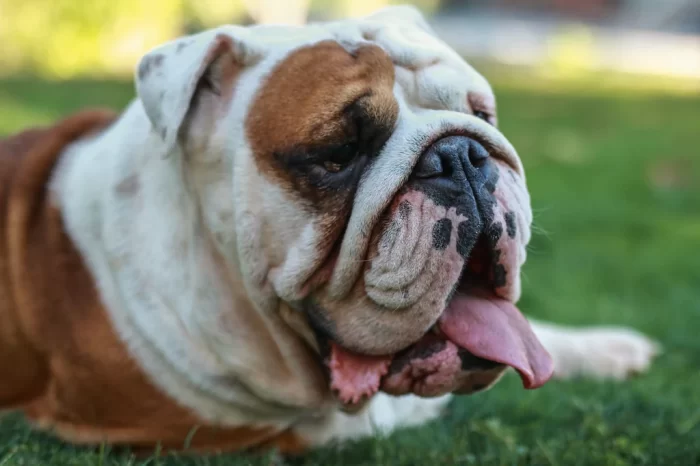English Bulldogs are a brachycephalic (short-nosed) breed that can be prone to respiratory problems due to the anatomy of their airways. As an English Bulldog owner, being proactive and preventative when it comes to your dog’s respiratory health is crucial. In this article we talk about English Bulldog Health Guide-Preventing Respiratory.
Table of Contents
Monitor Your Home Environment
As brachycephalic dogs don’t tolerate heat well, take steps to keep your home cool and well-ventilated. Air conditioning is ideal during warm months. Ensure your Bulldog has access to plenty of fresh, clean water at all times to stay hydrated. Humidity can also be an irritant – use a dehumidifier as needed. Avoid exposing your English Bulldog to dust, smoke, pollen or other air pollutants that can further restrict their airways.
Maintain a Healthy Weight
An overweight English Bulldog will have increased difficulty breathing. Establish a regular feeding schedule, avoid overfeeding treats, and make sure your dog receives adequate exercise. Consult your veterinarian to determine an optimal weight range for your Bulldog based on factors like age, build, and activity level. Monitoring for weight gain and adjusting food portions accordingly is key.
Exercise Appropriately
While exercise is important, English Bulldogs should not be overexerted, especially in hot, humid weather. Low-impact activities like short walks or playing in a fenced yard are best. Always allow your Bulldog to rest when they want to stop. Never exercise your English Bulldog right before or after meals when their oxygen demand is highest.
Avoid Respiratory Irritants
Steer clear of activities that expose your English Bulldog to smoke, dust, pollen, or chemicals from household cleaners that can further inflame their airways. Also avoid letting your dog pull on their leash, which can put pressure on their windpipe and make breathing more difficult. Use a harness instead.
Practice Good Dental Care
Tartar buildup and advanced periodontal disease are common in English Bulldogs and can cause bacteria from the mouth to spread to the lungs. Brush your dog’s teeth daily, feed dental treats, and have regular professional cleanings at your vet clinic. This will reduce respiratory infections originating from poor oral health.
Administer Medications as Prescribed
If your vet prescribes any long-term medications like bronchodilators or corticosteroids for respiratory issues, carefully follow their directions for dosage and timing. Never abruptly stop prescribed medications without first consulting your vet.
Consider Airway Surgery
In severe cases, surgery may be recommended to open up constricted nasal passages or shorten excessively long soft palates that can obstruct airways. Though invasive, these procedures can significantly improve breathing capacity and quality of life. Discuss suitability with your veterinarian.
Keep Nails Trimmed
Long toenails can exacerbate problems with proper footing and posture, which can negatively impact breathing. Check and trim your English Bulldog’s nails regularly to prevent this.
Use a Harness for Walks
Rather than a neck collar, use a comfortable dog harness for any walks or outdoor activities. This avoids putting pressure on your Bulldog’s windpipe when pulling or lunging. A harness disperses pressure more evenly across the chest instead.
Avoid Stressful Situations
Stress and anxiety cause rapid breathing which can trigger respiratory distress in English Bulldogs. Minimize environmental stressors, avoid overly rowdy play, and use a ThunderShirt or other calming aids during situations that make your dog tense or nervous.
Recognize Warning Signs
Learn to spot common signs of respiratory distress in English Bulldogs: coughing/gagging, noisy/labored breathing, blue-tinged gums/tongue, drooling, wheezing, lethargy, collapsing. Call your vet promptly if you observe any combination of these. Rapid response to emerging issues prevents worsening.
Use Air Purifiers
Invest in HEPA air purifiers for your home to continually filter out irritating particles, allergens, and chemicals from your Bulldog’s environment. This improves overall air quality. Place them in rooms where your dog spends the most time.
Clean Bedding Frequently
Dust mites and skin dander can accumulate readily in fabrics. Wash your English Bulldog’s bed covers, pillows, and stuffed toys weekly in hot water to eliminate respiratory irritants they may inhale while sleeping or resting nearby.
Avoid Extreme Temperatures
Take extra precautions in very hot or very cold weather to avoid temperature extremes that amplify your English Bulldog’s breathing issues. Use climate control, limit time outdoors, provide jackets/booties, and watch closely for signs of heat stroke/hypothermia.
Secure Proper Diagnosis
If your English Bulldog has ongoing respiratory symptoms, pursue specialized veterinary testing like laryngeal exams, CT scans, rhinoscopy, bronchoscopy. Pinpointing the exact anatomical cause through imaging and scoping allows for the best treatment plan.
The shortened snouts, narrow nostrils, elongated soft palates, and other distinct facial features that give English Bulldogs their characteristic flat-faced appearance also make them prone to breathing difficulties. As an owner, staying vigilant about prevention and early intervention when respiratory problems arise is paramount to your Bulldog’s wellbeing. Consistently implementing these tips and lifestyle measures will assist greatly in supporting healthy respiration. I sincerely hope you find this “English Bulldog Health Guide-Preventing Respiratory” article helpful.
🔗 More SuhDog Resources

Dr. Amanda Davis is the lead writer for SuhDog.com and holds a Master’s degree in Animal Behavior. With over 8 years of experience, she specializes in canine behavior and training. Dr. Davis is a trusted voice in the pet care community, contributing to various pet magazines and speaking at industry conferences. Follow her on Instagram: @suh_dog_.

